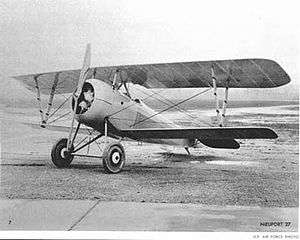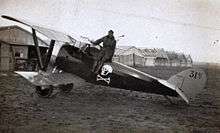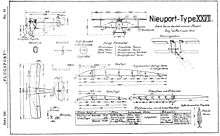Nieuport 27
| Nieuport 27 | |
|---|---|
 | |
| Nieuport 27 serving with the U.S. forces as an advanced trainer in 1918 | |
| Role | fighter / advanced trainer |
| National origin | France |
| Manufacturer | Nieuport, Nieuport-Macchi |
| Designer | Gustave Delage |
| First flight | 1917 |
| Introduction | October 1917 |
| Primary users | Aéronautique Militaire Royal Flying Corps Corpo Aeronautico Militare |
| Developed from | Nieuport 24 |
The Nieuport 27 was a French sesquiplane fighter aircraft during World War I designed by Gustave Delage. The model 27 was the last of the line of Nieuport "V-strut" single seat fighters stemming from the Bébé of early 1916. A few operational examples supplemented the very similar Nieuport 24bis in operational squadrons in late 1917 but most examples of the type served as advanced trainers.
Design and development
The Nieuport 27's design closely followed the early form of the 24, including its semi-rounded rear fuselage and rounded wingtips and ailerons. The structural problems with the redesigned, rounded tail surfaces of the 24, which had resulted in the use of a Nieuport 17 type tail in the 24bis., were by now overcome, so that the new version was able to standardise on the new tail. By now most Nieuport fighters were actually used as advanced trainers, and the 130 hp Le Rhône Rotary engine of the 24bis. was often replaced by a 110 or 120 hp version.
The handful of operational Nieuport 27s were armed either with a synchronized, fuselage-mounted Vickers machine gun (in French service) or a Lewis Gun mounted on a Foster mounting on the top wing (in British service). Two guns were occasionally fitted, but this had a severe effect on performance, which was at best little better than that of earlier models.[1]
Operational history

The type served in small numbers with the French Aéronautique Militaire and also with the British Royal Flying Corps/Royal Air Force during 1917 and early 1918, supplementing or replacing the Nieuport 24bis. However, by spring 1918, most Nieuport "V strut" fighters had been withdrawn from front line service and replaced - with SPAD S.XIIIs in French service, and with Royal Aircraft Factory S.E.5as in the RFC/RAF.[2]
The type was supplied to Italy, and built there by the Nieuport-Macchi Company at Varese, although the Italians ultimately preferred the Hanriot HD.1. Some 120 Nieuport 27 aircraft were bought for the United States Army Air Service for use as trainers in 1918. French ace Charles Nungesser was the most famous pilot to use the 27.[2]
In 1919 Poland bought one Nieuport 27.
Operators
- Polish Air Force - 1 aircraft
- Imperial Russian Air Service
- Soviet Air Force - Taken over from the Imperial Russian Air Force.
- Bulgarian Air Force - One captured Nieuport 27, formerly N5346
- Royal Yugoslav Air Force - Postwar.
Specifications

Data from World Encyclopedia of Military Aircraft p42[3]
General characteristics
- Crew: One
- Length: 5.88 m (19 ft 3½ in)
- Wingspan: 8.18 m (26 ft 10 in)
- Height: 2.44 m (8 ft)
- Empty weight: 354 kg (782 lb)
- Loaded weight: 544 kg (1,200 lb)
- Powerplant: 1 × Le Rhone Rotary, 90 kW (120 hp)
Performance
- Maximum speed: 187 km/h (116 mph)
- Range: 249.55 km (155 miles)
- Service ceiling: 5,550 m (18,200 ft)
- Rate of climb: 3.78 meters per second (745.45 feet per minute)
Armament
- French or Italian service 1 × synchronised Vickers machine gun
- British service 1 × Lewis gun on Foster mounting on upper wing
- USAS service unarmed advanced trainers
References
Notes
- ↑ Taylor and Alexander 1969, pp. 116–117.
- 1 2 "Nieuport 27." theaerodrome.com. Retrieved: 20 December 2010.
- ↑ Angelucci 1987, p. 42.
Bibliography
- Angelucci, Enzo. The American Fighter: The Definitive Guide to American Fighter Aircraft From 1917 to the Present. New York: Orion Books, 1987. ISBN 0-517-56588-9.
- Cheesman E.F.,ed. Fighter Aircraft of the 1914–1918 War. Letchworth, UK: Harletford Publications, 1960, pp. 96–97.
- Cooklsley, Peyter. Nieuport Fighters in Action. Carrollton, TX: Squadron/Signal Publications, 1997. ISBN 978-0-89747-377-4.
- Taylor, John W. R. and Jean Alexander. Combat Aircraft of the World. New York: G.P. Putnam's Sons, 1969. ISBN 0-71810-564-8.
- Janić Č, Petrović O, Short History of Aviation in Serbia, Beograd, Aerokomunikacije, 2011. ISBN 978-86-913973-2-6.
External links
| Wikimedia Commons has media related to Nieuport 27. |